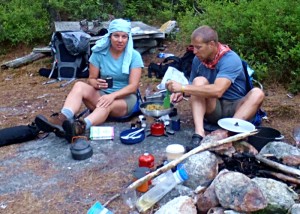
Ultralight backpacking has a certain joy to it. Minimalist and simple, Ramen noodles from a kettle, little planning needed…pack up and go!
Which, of course, explains why we almost never do it. We’re gear junkies, foodies, wine-in-the-woods lovers. The juxtaposition of a backpacking camp with gourmet level food heightens our enjoyment of both. However, there are some tradeoffs, and one of them is that to make a great meal in the woods usually requires carrying a LOT of weight in cooking gear.
One item that’s always heavy and bulky is a frypan. If you’re going to feed 4 people a great meal, you can’t do it in a tiny pan, and when you’re working with a stove with a small burner, you need a pan that has excellent heat distribution in order to avoid a bunch of food that’s raw with one burnt spot. That means a thick, heavy pan…or does it?
There’s no secret that we’re fans of GSI Outdoors. They’ve always made an innovative range of quality products, from the nesting wine glasses that allow us to be pretentious miles out in the woods, to a tiny pepper grinder that actually works, to the Dualist setup that we use when we actually ARE doing ultralight, minimalist camping. So, when I was looking for a replacement for my big honking heavy 12″ frypan that goes on trips with 4 or more people, it only made sense to see what they had to offer.
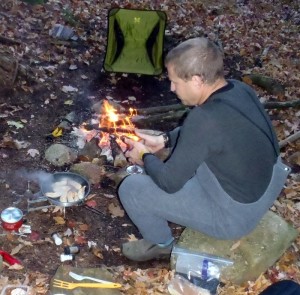
Unfortunately, that’s harder than it sounds, as GSI has one of the worst search engines ever to exist on a website. Typing in “frying pan” gets nothing. Irritating. But, after a few abortive attempts, I hit on “frypan”…ah, 37 results. That’s more like it. And, it became clear very quickly that the Pinnacle series, the same product group that produced the Dualist, was where we wanted to be. But, after reading the product specs and measuring my old pan, I realized that the GSI Outdoors Pinnacle 10-Inch Frypan would replace my 12″. It’s much deeper and has a steeper slope to the sides, giving it almost as much internal volume as my old one, while making it both harder to spill from and much more stable on a canister stove. Out went my order, in came the pan.
Immediately, it was obvious that it’s a quality piece. Solid and rigid, it uses the same “Teflon with Radiance” coating that has been such a hit on their other products; it’s very slippery, very durable, and spreads heat more evenly. We’ve been able to cook quality meals on the other products we’ve tried with that technology, even under highly adverse conditions. The folding handle is solid and stable when opened, and is nice and light; and, like the smaller diameter, helps make the pan even less tippy when put onto a canister microstove. Adding to both its stability and the even heating characteristics is a deeply ridged bottom surface. It keeps the pan from sliding around on the stove, and the grooves both increase the surface area and “catch” the flame, making it more efficient and faster to both heat and cool, allowing more precise cooking.
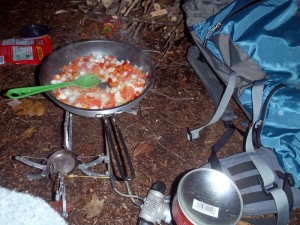
Of course, that’s all in theory; it’s in the field that performance flaws show up. But, in this case, none were to be found. A trip to pick blueberries in a high mountain meadow meant pancakes for breakfast. Sheer laziness meant “oh, dump the whole mess in and see what happens!” End result was a 10″ diameter blueberry pancake that was about a half inch thick, almost perfectly evenly brown, and delicious. (Note to self: A large single pancake doesn’t absorb as much butter and syrup as a bunch of small ones, which is disappointing, if healthy.)
Over the next 5 months, the Pinnacle frypan got used for everything from frying freshly caught trout to boiling pasta to searing venison steaks (and then having EggBeaters thrown into the pan the next morning to take advantage of the pan juices). High temperatures, low temperatures, it didn’t care; it cooked well and evenly. The only negative was that, like pretty much every pan we’ve ever used that wasn’t made of cast iron, it developed a slight doming of the bottom, so whatever you put in there is thinnest in the center where the most heat is. That’s a simple problem to solve, though, by stirring once in a while (or often when the stove’s in blowtorch mode). We seared Chinese potstickers, then added water and simmered them while sitting in Tim’s big tipi with 8 EasternSlopes.com writers at the Hulbert Outdoor Center’s Winter Skills Day; no sticking, and no complaints from the crew! Basically, we did everything we’d do with our sautè pans at home, and the Pinnacle came through with flying colors.
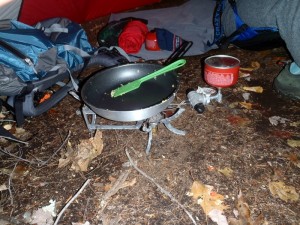
Final analysis, if you’ve got limited space at home for long handled pans, you could do worse than to stick this in your cupboard. For backpacking, the GSI Outdoors Pinnacle 10-Inch Frypan is a revelation to us; ease of use, safety, and quality results put it head and shoulders above all other frypans we’ve used. Yes, you need to pay attention to not scratching the coating (they claim that Radiance is much tougher than regular Teflon, but that’s like saying brown eggs have harder shells than white; they all still crack), but that’s a small price to pay for the ease of cleanup in camp, and for having your food evenly cooked without sticking. Now I have to get the 8″ to replace my smaller pan…


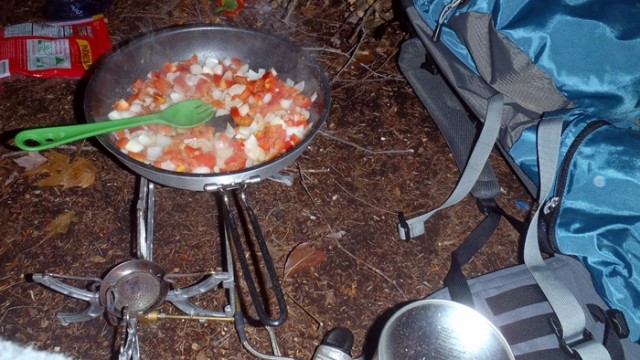
“a trip to pick blueberries in a high mountain meadow”—-in March? Where are you guys from?
Elizabeth,
Thanks for writing. You clearly missed the start of the next paragraph which says “Over the next 5 months the Pinnacle frypan got used for everything from frying freshly caught trout to boiling pasta to searing venison steaks . . .”
We started testing the GSI Pinnacle frypan in August (when there were, indeed, blueberries) and finally decided in January that it had earned our recommendation.
We’d like to take this opportunity to point out that, at EasternSlopes.com, we don’t form our opinions in seconds and flame them out to the world. Instead, we actually test the gear we write about in a variety of conditions over a span of time. We believe that this approach allows us to offer equipment recommendations that are of genuine value to our readers. We hope you agree.
Good to hear that this pan is durable. I think I’ll end up picking one up. I’ve used the non-stick coated steel pan in the past for car camping and found that the non-stick coating doesn’t hold up very well at all.
For backpacking, I’m more likely to take one of MSR’s fry pans.
Matt, our is finally reaching the stage where we are thinking we should pick up another one…but we’re still using it! We’ve managed to rub off the coating in one spot in the center, most likely from carrying other things inside it in the pack, but it’s a small spot and only a minor irritation. We’ve overheated it and domed the bottom and beaten it back into shape, and it just keeps working for us. Hope yours works as well!
The pan in your picture is the Bugaboo model without the hard anodized coating. The Bugaboo is not as durable as the pinnacle series. I’ve had both and the Pinnacle is one of my favorite pieces of gear. A lid can be found at the goodwill for a couple of bucks. With a proper lid you can bake in these pans. The thinner walled MSR pans will burn.
Gear Head, you’ve got great eyesight! And, you’re correct, the Pinnacle now has a hard anodized coating, but at the time we wrote the article it didn’t. GSI has made changes to the line, and while we haven’t confirmed that what was Pinnacle is now Bugaboo without any other changes, it’s likely. Glad you’re enjoying yours…ours is still alive (although it really is due for an update, due to all of the dents and dings).